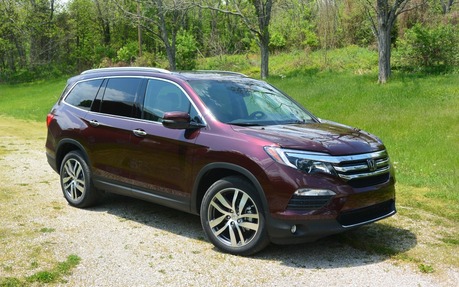2016 Honda Pilot: A Complete Makeover
With a boxy shape and a dashboard peppered with all kinds of buttons and controls, the second-generation Honda Pilot wasn't exactly the most elegant car out there. And driving it was more like driving a pickup than a family SUV. That said, it still had some good qualities. Its fit and trim was impeccable, its reliability was reassuring, and it was extremely versatile. Plus, all-wheel drive helped make going off the beaten track less treacherous.
But the competition stepped up its game over the years, and after six years on the market, the Pilot needed to be replaced. This lifespan is in keeping with industry standards, as six years is the normal life cycle for a vehicle these days.
True to form, the brass at Honda asked Pilot owners what they wanted kept and what they wanted improved. The 2016 version represents the answers they got.
Optical illusion
When we attended the presentation, very little time was dedicated to the design features. They mentioned that the head and taillights incorporated LED lamps and that the alloy rims were 18 or 20 inches, depending on the trim level. Several components were highlighted in the passenger compartment, including heated and ventilated seats, digital indicators, an eight-inch rear entertainment screen and two panoramic sunroofs.
But almost nothing in the way of pure design was really mentioned, though that didn’t stop us from drawing our own conclusions. The exterior silhouette is subdued but modern and gives the impression that the vehicle is smaller than it actually is—unlike the previous brick-like version. Character lines under the beltline and just above the rocker panel lighten the silhouette and reduce the tension of the side panels. The wheel wells are not very prominent and a chrome rod separating the window from the body keeps the exterior from looking haphazard.
The grille is made up of three chrome rods, with the top one extending above the headlights. There’s an air intake on each end of the front bumper, which takes away from its otherwise reasonably even design.
The control modules add character to the understated dashboard. Note that the air conditioning controls aren’t so easy to understand. The shifter is located on the left of the central console. It’s very intuitive and follows the current trend of replacing the traditional stick with an alternative, be it a dial (Chrysler), a small lever on the steering column (Mercedes-Benz) or even a retractable button (Jaguar). The push buttons aren’t new for Honda, as this configuration was used on the Acura RLX last year.
The central console includes five USB ports in its back part, including four with a 2.5-amp capacity, for recharging electronic devices like your cell, computer or tablet.
The Pilot can seat seven or eight people, depending on whether you’ve got a bench or two captain’s chairs in the second row. To access the third row, just press a button to slide the second-row seats forward. Legroom is still very limited in back.
The baggage hold is spacious with a 3,092-litre capacity behind the front seats, 1,583 litres behind the second row and 524 litres with all the seats in place.
Finally, there’s a loading space under the floor at the edge of the baggage area if you want to carry more stuff. Proving the designers’ plan to make the Pilot as complete and versatile as possible, the in-floor storage’s cover is reversible and has one carpeted side and one textured rubber side.
This time, nothing was forgotten
For a long time, Honda relied on mechanical sophistication and reliability to attract clients but, these days, buyers expect more. The common perception is that while Honda is very sound from a technological point of view and has many positives, it lags behind in other areas.
Honda went all out with the new Pilot in terms of safety and practicality accessories. Sure, these aren’t necessarily innovative elements in and of themselves, but they’re almost all available in one vehicle and are among the most sophisticated in their category.
It has the very latest Garmin navigation system that is able to modify your itinerary based on traffic conditions, while the new Sirius XM satellite radio lets you benefit from automatic channel backtracking, set up an alternating playlist and get sports updates at regular intervals.
Basically, there’s a bunch of accessories aimed at making life on board easier, including an entertainment system with an eight-inch screen for the backseats.
Safety, of course
Due to a gag order, we can’t leak the main mechanical features and various safety systems on board. We’ll also have to wait until May 20th before giving our impressions of the ride. However, we can say that the new Pilot will be equipped with systems like blind spot detection, collision prevention, lane drift correction and a whole host of others. The 3.5-litre V6 is the only engine offered.
In the meantime, this new version of the Pilot is more elegant and sophisticated—and it's lightyears ahead of the previous gen. Check in on May 20th for more info!
| Test drive report | |
| Test model | 2016 Honda Pilot |
|---|---|
| Trim level | Touring 4WD |
| Price range | $35,100 – $48,850 |
| Price as tested | 48 850 $ |
| Warranty (basic) | 3 years/60,000 km |
| Warranty (powertrain) | 5 years/100,000 km |
| Fuel economy (city/highway/observed) | 12,4 / 9,3 / N/A L/100km |
| Options | N/A |
| Competitive models | Buick Enclave, Chevrolet Traverse, Ford Explorer, Ford Flex, GMC Acadia, Hyundai Santa Fe, Infiniti QX60, Jeep Grand Cherokee, Kia Sorento, Lincoln MKX, Mazda CX-9, Nissan Pathfinder, Subaru Outback, Toyota Highlander |
| Strong points | N/A |
| Weak points | N/A |
